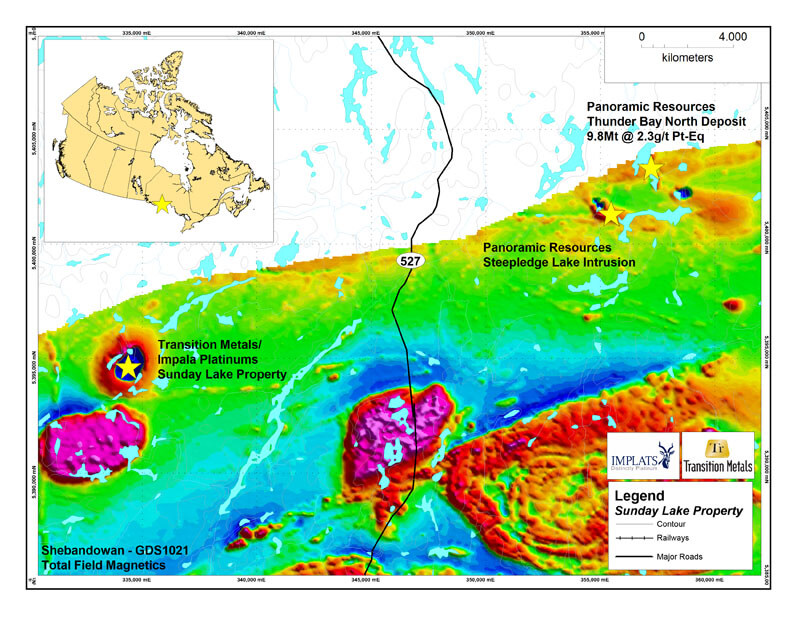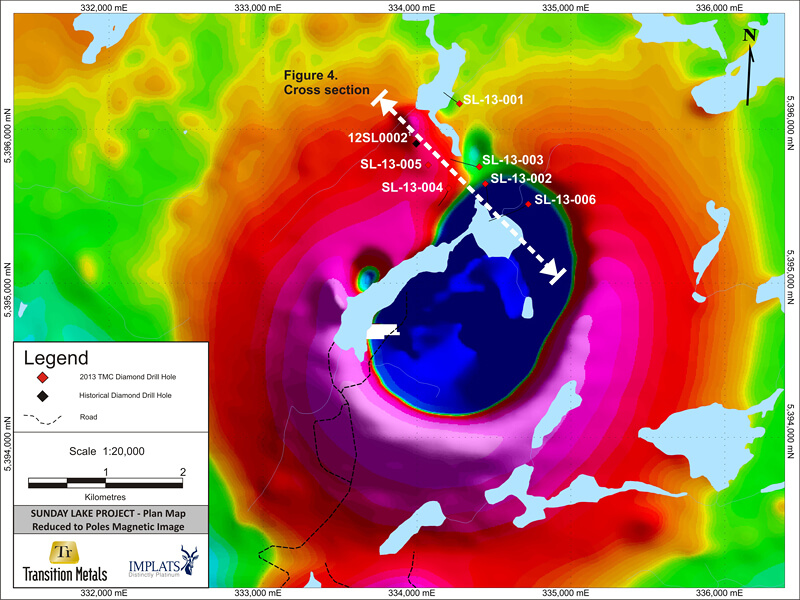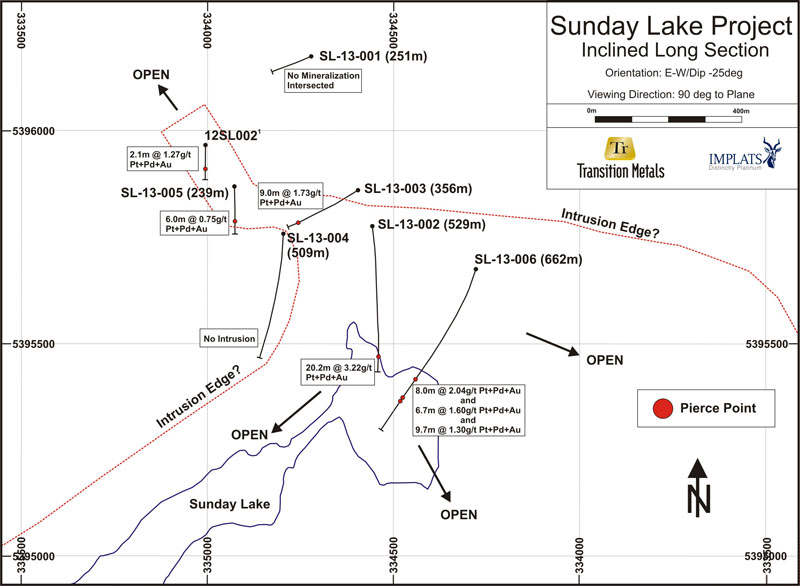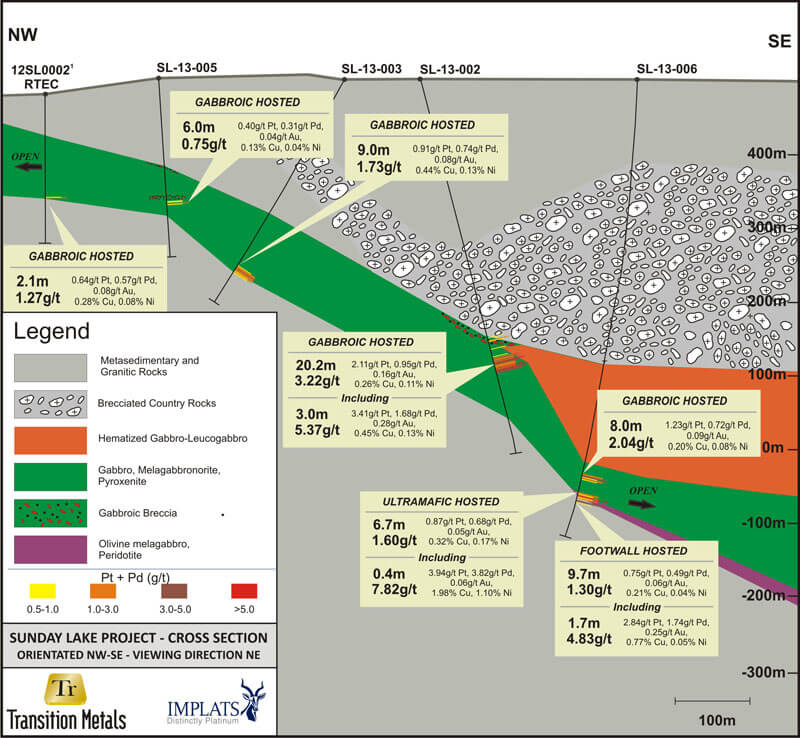27 January 2014
Posted in Press Release, 2014, Alliance, Sunday Lake
Sudbury, January 27, 2014 – Transition Metals Corp. (XTM – TSX.V) ("Transition", "the Company"), is pleased to announce assay results from its drilling program at the company's 50% owned Sunday Lake Project, located near Thunder Bay, Ontario. The program was completed during the fall of 2013 in partnership with Impala Platinum Holdings Limited (Implats). Of the six diamond drill holes completed (2,546 meters in total), four returned intersections containing significant platinum-rich mineralization, including hole SL-13-002 which intersected 20.2 meters containing 3.22 g/t combined precious metals (Pt+Pd+Au or PGMs).
Assay results from the 2013 drill program are summarized below:
Table 1: Summary of Drill Intersections
| Drill Hole | From (m) |
To (m) |
Length (m) |
Pt (g/t) |
Pd (g/t) |
Au (g/t) |
PGMs (Pt+Pd+Au) (g/t) |
Cu (%) |
Ni (%) |
S (%) |
| SL-13-002 | 369.4 | 371.8 | 2.40 | 0.87 | 0.46 | 0.03 | 1.36 | 0.03 | 0.04 | 0.72 |
| and | 395.0 | 415.2 | 20.20 | 2.11 | 0.95 | 0.16 | 3.22 | 0.26 | 0.11 | 1.22 |
| including | 410.0 | 413.0 | 3.00 | 3.41 | 1.68 | 0.28 | 5.37 | 0.45 | 0.13 | 1.23 |
| SL-13-003 | 299.0 | 308.0 | 9.00 | 0.91 | 0.74 | 0.08 | 1.73 | 0.44 | 0.13 | 3.05 |
| including | 302.0 | 303.0 | 1.00 | 1.73 | 1.43 | 0.15 | 3.31 | 0.86 | 0.24 | 3.05 |
| SL-13-005 | 164.6 | 170.60 | 6.00 | 0.40 | 0.31 | 0.04 | 0.75 | 0.13 | 0.04 | 0.59 |
| including | 167.6 | 168.6 | 1.00 | 0.66 | 0.59 | 0.09 | 1.34 | 0.31 | 0.07 | 0.97 |
| SL-13-006 | 567.0 | 575.0 | 8.00 | 1.23 | 0.72 | 0.09 | 2.04 | 0.20 | 0.08 | 0.48 |
| and | 595.7 | 602.4 | 6.70 | 0.87 | 0.68 | 0.05 | 1.60 | 0.32 | 0.17 | 2.36 |
| including | 602.0 | 602.4 | 0.40 | 3.94 | 3.82 | 0.06 | 7.82 | 1.98 | 1.10 | 18.3 |
| and | 602.4 | 612.1 | 9.70 | 0.75 | 0.49 | 0.06 | 1.30 | 0.21 | 0.04 | 0.95 |
| including | 607.4 | 609.1 | 1.70 | 2.84 | 1.74 | 0.25 | 4.83 | 0.77 | 0.05 | 1.11 |
Please refer to Figures 1 through 4 which present the generalized location of the Sunday Lake project, a plan map depicting the location of the grids and drill holes on a backdrop of total field magnetics, a long sectional view depicting the relative position of intercepts, and an interpreted geological cross section. If you are having difficulties viewing the figures please visit the Sunday Lake project section at www.transitionmetalscorp.com or use the following link to download the pdf version of this release. Commenting on the program, CEO Scott McLean stated “We are extremely pleased with this new platinum discovery. While still at an early stage of exploration, positive features include; the large size of the intrusion, the widespread occurrences of multiple mineralized environments and high Pt tenors. We consider these factors to be very encouraging and believe that we may have discovered a large scale mineralized system.”
SL-13-001 (251m: 300°/-60°): The hole failed to intersect mineralization but did intersect several narrow mafic dikes (<1 metre) that have geochemically been shown to be related to the Sunday Lake Intrusion (SLI).
SL-13-002 (529m: 180°/-75°): The hole intersected a 150.7m wide zone of intensely brecciated and altered country rock followed by 118.1 metres of the SLI. The intrusion ranged in composition from gabbro through to pyroxenite and contained a 20.2 metres zone of sulphide mineralization from 395.0-415.2 metres that contained 3.22 g/t PGMs including a higher grade zone that contained 5.37 g/t PGMs 3.0 metres.
SL-13-003 (356m: 280°/-60°): The hole intersected 95.6 metres of the SLI from 212.2-307.8 metres and contained a 9.8 metre wide zone from 299.0-308.8 metres of coarse-grained blebby chalcopyrite (cpy)+pyrhhotite (po) in a fine-grained gabbro that returned assay values of 1.64 g/t PGMs.
SL-13-004 (509m: 190°/-80°): Due to excessive deviation in the hole, the hole failed to intersect the main intrusion. The hole did intersect several narrow mafic dikes (<1 metre) that have geochemically been shown to be related to the SLI.
SL-13-005 (239m: 135°/-85°): The hole intersected 68.1 metres of the SLI from 117.7-185.8 metres and contained a 6.0 metre wide zone from 164.6-170.6 metres of coarse-grained blebby cpy+po in a variable textured hornblende-gabbro to fine-grained gabbro that returned assay values of 0.75 g/t PGMs including 1.0 metre grading 1.34 g/t PGMs.
SL-13-006 (662m: 235°/-75°): The hole intersected 194.6 metres of the SLI from 407.8-602.4 metres and contained three distinct zones of PGE-bearing sulphide mineralization. Coarse-grained blebby cpy-po, hosted within a vari-textured hornblende-gabbro to fine-grained gabbro was intersected over 8.0 metres from 567.0-575.0 metres and returned 2.04 g/t PGMs. Peridotite-hosted sulphide mineralization containing 1.6 g/t PGMs was encountered over a 6.7 metre interval from 595.7-602.4 metres along the basal contact of the intrusion. Included in this interval was a 0.40 metre zone of semi-massive sulphide (cpy+po) which returned 7.82 g/t PGMs, 1.98% Cu and 1.1% Ni. In the footwall immediately adjacent to the intrusion a 9.7 metre zone of sulphide mineralization was intersected that contained 1.3 g/t PGMs. The mineralization was dominated by coarse-grained blebby sulphide (cpy-po) as well as stringers of sulphides (cpy-po) hosted within thermally altered metasediments. Included within this interval were higher grade sections that returned 4.83 g/t PGMs, 0.77% Cu & 0.05% Ni over 1.7m.
2014 Round-up Conference in Vancouver
Polished specimens of Sunday Lake drill core and some posters will be on display by company representatives in the AMEBC Core Shack venue at the Westin Bayshore hotel in Vancouver this week on Tuesday January 28th, 2014 at 1601 Bayshore Drive. Conference participants are encouraged to drop by the core shack.
2014 Exploration Program
The Company is working with partner Implats to follow-up on these encouraging results by expanding geophysical coverage over the property and by completing borehole electromagnetic surveys in preparation for additional drilling. Objectives for the next phase of work at Sunday Lake include testing of other defined geophysical targets and follow-up drilling to further define the extent and continuity of intersected mineralization.
About the Sunday Lake Property
The Sunday Lake Property is located approximately 25 km north of Thunder Bay and 25 km west of Panoramic Resources Limited's, Thunder Bay North deposit and consists of staked claims and privately owned land optioned in 2013 from Rio Tinto Exploration Canada Inc. (RTEC) and other property holders. The property covers a 3.5 km diameter circular reversely-polarized magnetic anomaly associated with the large buried mafic-ultramafic intrusion interpreted to be Proterozoic in age and related to the Midcontinental Rift (MCR). The MCR is a 2,000 km long geological rift in the center of North America that formed when the North American craton, began to split apart about 1.1 billion years ago. Early phases ('early-rift') of mafic to ultramafic intrusive rocks, with high associated PGMs occur within the MCR. In recent years, several deposits have been discovered in the MCR, including:
Qualified Person
The technical elements of this press release have been approved by Mr. Grant Mourre, P.Geo. (APGO), a Qualified Person under National Instrument 43-101. All samples were analyzed in Vancouver by ALS Chemex. Platinum, palladium and gold values were determined together using standard lead oxide collection fire assay and ICP-AES finish. Base metal values were determined using lithium metaborate fusion and ICP-MS. Standards and blanks are submitted with each sample batch.
1Resource reported by Lundin Mining, July 2013 NI 43-101 Technical Report on the Eagle Mine, Upper Peninsula of Michigan, USA
2Resource reported by Panoramic Resources, Thunder Bay North deposit: 2011 JORC compliant mineral resources estimate prepared by AMEC Americas Ltd.
About Transition Metals Corp
Transition Metals Corp (XTM -TSX.V) is a Canadian-based, multi-commodity project generator that specializes in converting new exploration ideas into Canadian discoveries. The award-winning team of geoscientists has extensive exploration experience in established, emerging and historic mining camps, and actively develops and tests new ideas for discovering mineralization in places that others have not looked, which often allows the company to acquire properties inexpensively. The team is rigorous in its fieldwork, and combines traditional techniques with newer ones to help unearth compelling prospects and drill targets. Transition uses the project generator business model to acquire and advance multiple exploration projects simultaneously, thereby maximizing shareholder exposure to discovery and capital gain. Joint venture partners earn an interest in the projects by funding a portion of higher-risk drilling and exploration, allowing Transition to conserve capital and minimize shareholder's equity dilution. The company, which went public in 2011, has an expanding portfolio that currently includes 30 gold, copper, nickel and platinum projects primarily in Ontario, Nunavut and Saskatchewan.
Cautionary Note on Forward-Looking Information
Except for statements of historical fact contained herein, the information in this news release constitutes "forward-looking information" within the meaning of Canadian securities law. Such forward-looking information may be identified by words such as "plans", "proposes", "estimates", "intends", "expects", "believes", "may", "will" and include without limitation, statements regarding estimated capital and operating costs, expected production timeline, benefits of updated development plans, foreign exchange assumptions and regulatory approvals. There can be no assurance that such statements will prove to be accurate; actual results and future events could differ materially from such statements. Factors that could cause actual results to differ materially include, among others, metal prices, competition, risks inherent in the mining industry, and regulatory risks. Most of these factors are outside the control of the Company. Investors are cautioned not to put undue reliance on forward-looking information. Except as otherwise required by applicable securities statutes or regulation, the Company expressly disclaims any intent or obligation to update publicly forward-looking information, whether as a result of new information, future events or otherwise.
Neither the TSX Venture Exchange nor its Regulation Services Provider (as that term is defined in the policies of the TSX Venture Exchange) accepts responsibility for the adequacy or accuracy of this release.
Further information is available at www.transitionmetalscorp.com or by contacting:
Scott McLean
President and CEO
Transition Metals Corp.
Tel: (705) 669-0590
Robert Thaemlitz
Financial Communications
Renmark
Tel. (514) 939-3989
Figure 1. Location of the Sunday Lake Project 
Figure 2. Plan Map Depicting Location of Drill Holes on TFM Image

Figure 3. Inclined Long-Section – Looking North
'Hole 12SL0002 drilled by RTEC in 2012 - Interpretation based on logs filed for assessment with the Ontario Department of Mines – AFRI file 2.5355

Figure 4. Cross Section – Looking Northeast
'Hole 12SL0002 drilled by RTEC in 2012 - Interpretation based on logs filed for assessment with the Ontario Department of Mines – AFRI file 2.53552
